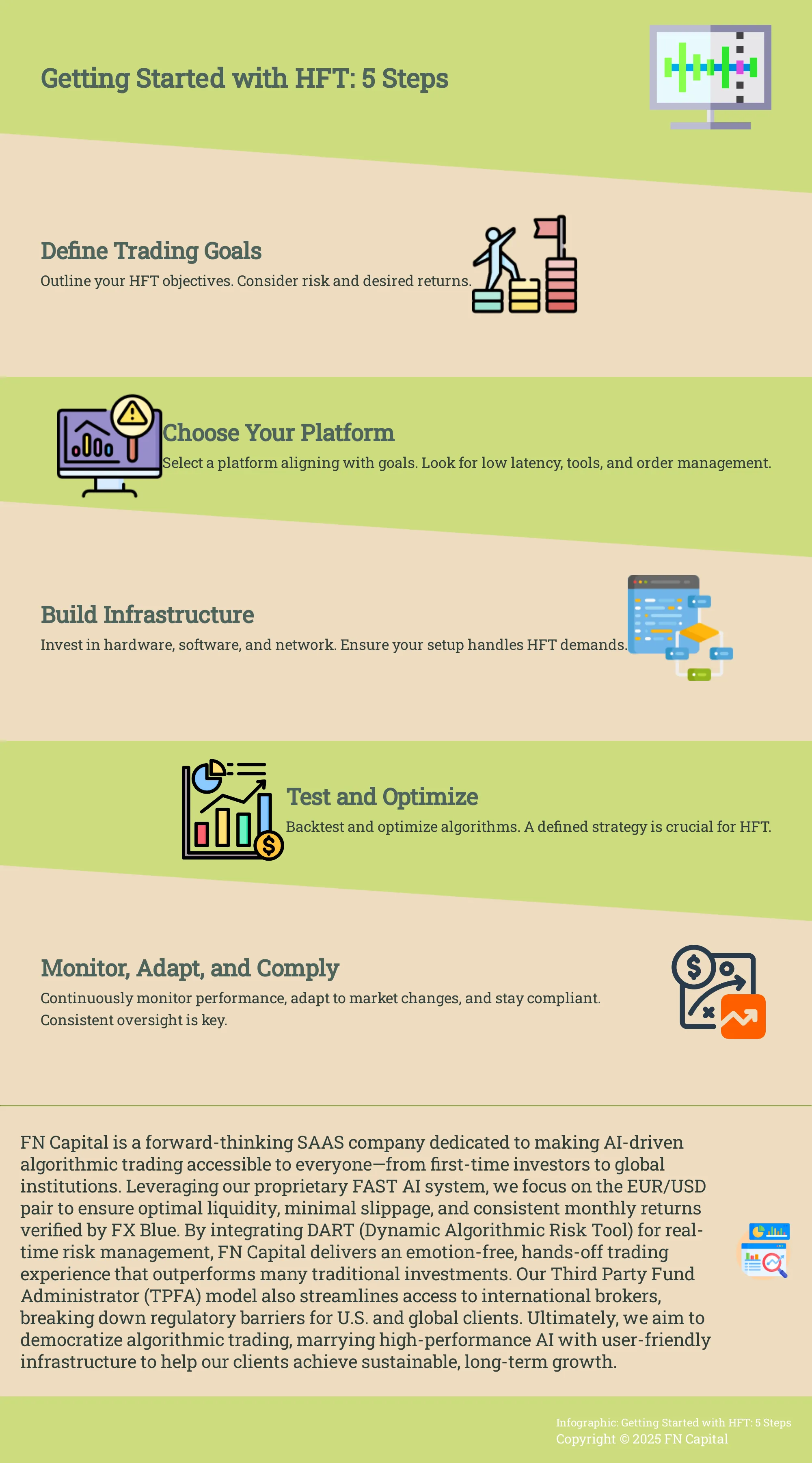High-frequency trading (HFT) often sounds like something out of a science fiction movie, with computers making thousands of forex trades in the blink of an eye. But it’s a very real and increasingly important part of the financial world. This article breaks down the complexities of HFT, making it accessible to traders of all levels. We’ll explore the core components of high-frequency forex trading solutions, from the technology that enables ultra-low latency execution to the algorithms that drive automated trading decisions. Join us as we uncover the potential of HFT and discuss the essential considerations for anyone looking to explore this dynamic trading approach.
Key Takeaways
- High-frequency trading (HFT) uses powerful tech to execute rapid-fire trades, profiting from tiny price changes. It’s different from traditional trading, so know what you’re getting into. Think about how often you want to trade, the tech you’ll need, and how you’ll manage risk.
- The right HFT platform needs fast execution, smart algorithms, and strong risk management. Match the platform’s features to your trading style. Can it handle lots of trades? What kind of support do they offer? These things matter.
- AI is changing the game in HFT, making analysis faster, trades automatic, and strategies smarter. Keep up with new tech like 5G and FPGAs. And don’t forget about regulations – staying compliant is key.
What is High-Frequency Forex Trading?
High-frequency trading (HFT) is a specialized type of algorithmic trading characterized by extremely rapid trade execution. It leverages powerful computers and sophisticated algorithms to make thousands of forex trades in fractions of a second, capitalizing on tiny price fluctuations. Think of it as automated trading on steroids. These systems are designed to identify and exploit fleeting market inefficiencies that are often too small or fast for human traders to notice.
Defining HFT in Forex
In the forex market, HFT firms use complex algorithms to analyze vast amounts of data, identify patterns, and execute trades with incredible speed and precision. These algorithms can react to market changes in milliseconds, making decisions based on real-time data feeds, news sentiment, and other relevant factors. This speed advantage allows HFT traders to capture small profits on a massive scale, adding up to significant gains over time. A key aspect of HFT is its focus on short-term opportunities, with positions often held for mere seconds or minutes. This contrasts sharply with traditional forex trading, where positions might be held for days, weeks, or even months. HFT is all about volume and velocity, squeezing profits from the smallest of price movements. For a deeper look at HFT, Investopedia offers a helpful overview.
How HFT Differs from Traditional Trading
The core difference between HFT and traditional forex trading lies in the speed and frequency of trades. Traditional traders typically rely on fundamental or technical analysis to make informed decisions about market direction. They might hold positions for extended periods, waiting for larger price swings to materialize. HFT, on the other hand, operates on a completely different timescale. HFT strategies are designed to exploit minuscule price discrepancies that exist for incredibly short durations. This requires advanced technology, complex algorithms, and a deep understanding of market microstructure. While traditional traders might make a handful of trades per day or week, HFT systems can execute thousands, even millions, of trades in the same timeframe. This high-frequency approach demands a different set of tools and expertise, as discussed in this article on AI in high-frequency forex trading.
Essential Features of High-Frequency Forex Trading Solutions
High-frequency forex trading solutions require specific features to succeed in the fast-paced currency market. These tools prioritize speed, precision, and efficiency, allowing traders to capitalize on fleeting market opportunities.
Ultra-Low Latency Execution
In high-frequency trading, milliseconds matter. Ultra-low latency execution is critical. This refers to how quickly your orders transmit to the market and execute. Even small delays can separate a profitable trade from a missed opportunity. New communication technologies like 5G networks play a crucial role in minimizing latency and ensuring your trades are executed as quickly as possible.
Advanced Algorithmic Capabilities
Sophisticated algorithms form the core of high-frequency trading. These algorithms automate trading decisions, executing trades based on pre-defined rules and market conditions. Strategies like statistical arbitrage and momentum trading identify and exploit short-term price fluctuations. Features like smart order routing and real-time analytics further enhance execution and minimize market impact.
Robust Risk Management Tools
Managing risk is crucial in any trading strategy, but even more so in high-frequency trading. The speed and volume of trades demand robust risk management tools. These tools offer real-time position monitoring, automated stop-loss orders, and other safeguards to protect your capital. A comprehensive platform will include features like advanced charting, order management, and portfolio tracking to help you manage risk effectively.
Real-Time Market Data Analysis
High-frequency trading depends on up-to-the-second market data. Real-time market data analysis is essential for spotting emerging trends and making informed trading decisions. FPGA solutions can pre-process market data, filtering out unnecessary information and ensuring your algorithms work with the most relevant and timely data. This allows traders to react instantly to market changes and execute trades efficiently.
Top High-Frequency Forex Trading Platforms
Choosing the right platform is crucial for high-frequency forex trading. Here’s a look at some popular options:
FN Capital’s FAST AI
FN Capital’s proprietary FAST AI algorithm automates forex trades, focusing on EUR/USD for optimal liquidity. It uses a Dynamic Algorithmic Risk Tool (DART) for real-time risk management and offers a 100-day money-back guarantee. Clients access international brokers through a Third Party Fund Administrator (TPFA) structure, simplifying regulatory compliance. You can explore FN Capital’s AI trading solutions to learn more. For those interested in the specifics of retail investing, asset management, or even private equity, FN Capital offers tailored approaches.
IC Markets
IC Markets is often ranked as a top choice for high-frequency trading due to its competitive pricing, especially beneficial for high-volume traders. The platform supports popular trading software like MetaTrader 4 and 5, as well as cTrader, providing flexibility for various trading strategies. ForexBrokers.com highlights IC Markets as a leading choice for high-frequency trading.
Pepperstone
Pepperstone is another strong contender, known for its competitive pricing and low barrier to entry with a $0 minimum deposit. It supports multiple trading platforms, catering to a range of trader preferences. Like IC Markets, Pepperstone is also recognized by ForexBrokers.com for its HFT capabilities.
FXCM
FXCM distinguishes itself through its support for various specialized platforms designed for algorithmic trading. With a minimum deposit starting at $50, it offers accessibility while providing the tools needed for more complex automated strategies. You can learn more about FXCM and other platforms suitable for high-frequency trading from this ForexBrokers.com guide.
Interactive Brokers
Interactive Brokers is a top choice for stock traders engaging in high-frequency trading, primarily due to its low costs and connectivity to numerous trading venues. This makes it a powerful option for those seeking to diversify their HFT strategies beyond forex.
Oanda
Oanda is a well-established name in the forex world, offering a user-friendly platform and a range of tools for analysis. While not specifically highlighted for high-frequency trading in the provided resources, Oanda’s robust platform and reliable execution may still appeal to some traders in this space. Oanda provides trading platforms suitable for various levels of experience.
Costs and Fees
When evaluating high-frequency forex trading solutions, understanding the fee structure is critical. It’s not just about the sticker price; various costs can impact your bottom line. Knowing what to look for and how to compare different offerings will help you make informed decisions.
Compare Spreads
One of the most significant costs in high-frequency trading is the bid-ask spread. This is the difference between the buying (ask) and selling (bid) price of a currency pair. Since high-frequency trading involves frequent transactions, even small spreads can add up and significantly impact profitability. Look for platforms and brokers that offer consistently tight spreads, especially during active trading periods. Comparing spreads across different providers is a fundamental step in choosing a cost-effective solution.
Understand Commission Structures
Beyond spreads, you’ll encounter various commission structures. Some platforms charge a flat fee per trade, while others use a tiered system based on trading volume or account balance. Understanding these commission structures is essential for calculating your true trading costs. A seemingly low per-trade commission might become less attractive if you’re executing a high volume of trades daily. Factor in potential volume discounts or other incentives when making your comparison.
Watch Out for Hidden Fees
Finally, be aware of hidden fees that can unexpectedly reduce your returns. These can include inactivity fees, withdrawal fees, data fees, or platform usage fees. Carefully review the terms and conditions of each platform and broker to uncover any potential hidden costs. Transparency is key. A clearly outlined fee schedule will give you a complete picture of the expenses involved and allow you to accurately assess the overall cost-effectiveness of the high-frequency trading solution.
Pros and Cons of High-Frequency Trading Solutions
High-frequency trading (HFT) offers unique advantages, but it’s not without potential drawbacks. Understanding both sides is crucial for anyone considering this trading approach.
Advantages of HFT
HFT’s speed and computational power allow it to capitalize on market inefficiencies often unseen by human traders. This translates into several key benefits:
- Profit from Minimal Price Fluctuations: HFT algorithms can pinpoint and profit from even the smallest price differences between currency pairs. These micro-profits, accumulated across a high volume of trades, generate substantial returns over time. This ability to leverage minimal price movements is a core strength of HFT.
- Enhanced Market Liquidity: The high volume of trades executed by HFT systems significantly contributes to overall market liquidity. This generally makes it easier and faster for all participants to buy or sell currencies, even in large quantities. Increased liquidity often results in tighter bid-ask spreads, benefiting everyone in the market.
- Streamlined Transactions: HFT automates the entire trading process, from order entry to execution, eliminating manual delays and ensuring swift transactions. This speed and automation are particularly valuable in the fast-paced forex market.
- Technological Advancement: HFT firms invest heavily in advanced technology, including powerful computers, low-latency connections, and sophisticated algorithms. These advancements not only benefit HFT traders but also drive innovation across the financial technology landscape.
Potential Risks and Challenges
While HFT offers compelling advantages, it’s important to be aware of the potential risks:
- Absence of Human Oversight: The speed and automation inherent in HFT remove human judgment from many trading decisions. This can be a disadvantage during unexpected market events or periods of high volatility. While algorithms excel at following programmed rules, they may lack the flexibility of human traders.
- Increased Market Volatility: The rapid-fire nature of HFT can amplify market volatility, potentially leading to flash crashes or sudden price swings. The 2010 Flash Crash demonstrated how HFT can contribute to market instability.
- Potential for Unfair Advantage: Some argue that HFT gives large, well-resourced firms an unfair advantage over smaller investors who may lack access to the same technology and infrastructure. This difference in resources can create an uneven playing field.
- Illusory Liquidity: While HFT can increase apparent market liquidity, this liquidity can vanish quickly during times of market stress. This can leave regular investors unable to execute trades at anticipated prices. This so-called “phantom liquidity” poses challenges for those who depend on stable market conditions.
AI’s Role in HFT
Artificial intelligence is rapidly changing how high-frequency forex trading (HFT) operates, bringing speed, efficiency, and adaptability to the forefront. Let’s explore how AI is transforming this fast-paced landscape.
AI-Driven Market Analysis
AI algorithms excel at analyzing massive datasets, a crucial advantage in the data-rich world of forex. These algorithms can identify subtle patterns and correlations in market data that would be impossible for a human trader to spot. This market analysis happens at lightning speed, allowing AI-powered systems to execute trades in milliseconds, capitalizing on fleeting market opportunities. By leveraging real-time information and responding to dynamic market conditions, AI provides a significant edge in HFT. For example, AI can detect arbitrage opportunities across different exchanges and execute trades to profit from the price difference before the opportunity disappears.
Automating Decisions
Speed is paramount in HFT, and AI excels at automating split-second decisions. Strategies like statistical arbitrage, which profit from tiny price discrepancies, and momentum trading, which capitalizes on short-term price trends, are perfectly suited for AI automation. Platforms using these strategies can execute thousands of trades per day, reacting to market fluctuations far faster than any human could. This automation is essential for staying competitive in the fast-paced forex market. It removes the element of human emotion and ensures consistent execution based on pre-defined parameters. Services like high-frequency trading software can help automate these decisions.
Machine Learning and Strategy Optimization
AI isn’t just about speed; it’s also about continuous improvement. Machine learning algorithms can analyze historical data and identify trends to optimize trading strategies over time. This predictive capability allows HFT systems to adapt to changing market conditions and refine their approach for maximum effectiveness. Articles on how AI is revolutionizing trading strategies offer further insights into this transformative technology. As these systems learn and evolve, they become increasingly sophisticated and better equipped to handle the complexities of the forex market. This constant optimization is a key advantage of AI-driven HFT. For instance, a machine learning algorithm might identify that a certain trading strategy performs better during specific market volatility levels and adjust its parameters accordingly.
HFT Regulations
High-frequency trading (HFT) operates within a complex and ever-evolving regulatory landscape. Different regulatory bodies around the world work to maintain market integrity and manage risk. Understanding these regulations is crucial for anyone involved with HFT.
Current Regulatory Environment
The current regulatory environment for HFT focuses on ensuring fair market practices and mitigating potential risks. Regulators like the CFTC acknowledge potential benefits of HFT, such as increased liquidity and tighter spreads. At the same time, they also address concerns around aggressive trading and market volatility. Ongoing research explores the role of HFT during market crashes and periods of extreme price fluctuations, which helps inform future regulatory changes. This dynamic relationship between HFT practices and regulatory oversight shapes the current trading environment.
Compliance for Traders
Traders using HFT strategies must prioritize compliance. This means understanding and following the rules set by regulatory bodies, which often include strict record-keeping requirements for all trading activity. These regulations aim to ensure transparency and prevent market manipulation. A robust compliance framework is essential, not only to avoid penalties but also to maintain market integrity and build trust. Staying informed about evolving compliance standards is an ongoing responsibility for HFT traders. Resources like those available from Congress.gov offer valuable information about the regulatory landscape and best practices.
Choose the Right HFT Solution
Finding the right high-frequency forex trading (HFT) solution requires careful consideration of your trading goals, available features, and long-term scalability. It’s not a one-size-fits-all situation; what works for one trader might not be suitable for another. Here’s a breakdown of key factors to help you make an informed decision:
Assess Your Trading Goals
Before exploring HFT solutions, define your trading goals. Are you focused on scalping small price movements, exploiting arbitrage opportunities, or implementing complex algorithmic strategies? Your objectives will heavily influence the type of platform and features you need. Aligning your goals with the right broker is crucial for successful high-frequency trading.
Match Features to Your Strategy
Modern HFT platforms offer various features, from basic order execution to sophisticated algorithmic trading strategies. Think about which strategies you plan to employ—statistical arbitrage, momentum trading, or other technical methods—and ensure the platform supports them. Research each broker’s offerings, including supported platforms (MT4, MT5, cTrader, iRESS), execution speeds, and suitable account types. Having the right tools can significantly impact your ability to capitalize on short-term price changes and market inefficiencies.
Consider Scalability and Support
As your trading activity increases, your HFT solution needs to adapt. Look for platforms offering ultra-low latency and the capacity to manage growing order flow without performance issues. Co-location services, placing your servers near the exchange, can be vital for minimizing latency. Consider the support and resources the platform provider offers. Factor in developing technologies like 5G networks, which can further reduce latency and improve connectivity, ensuring your HFT setup remains competitive. A scalable and well-supported solution allows you to adjust to market changes and expand your trading operations smoothly.
Get Started with High-Frequency Forex Trading
High-frequency trading (HFT) can seem complex, but understanding the core components simplifies the process. This section breaks down how to get started, covering essential skills, infrastructure setup, and strategy optimization. For those interested in a streamlined, AI-powered approach to HFT, explore FN Capital’s automated trading solutions.

Required Skills and Knowledge
While automated profits are attractive, HFT isn’t a guaranteed win. A deep understanding of the forex market is crucial. You should be comfortable analyzing currency pairs, understanding market volatility, and recognizing technical indicators. Technical proficiency is also essential. Depending on your approach, you might need to grasp programming languages or specialized trading software. Success in HFT depends heavily on the chosen system and its configuration, not just the concept itself. As ForexBrokers.com points out, many retail traders lose money in HFT, so realistic expectations and risk management are key.
Set Up Your Trading Infrastructure
Your trading infrastructure is the backbone of your HFT operation. A robust and reliable setup is essential for executing trades at the speed required for HFT. This involves selecting the right hardware, software, and network connections. Modern HFT platforms often incorporate strategies like statistical arbitrage and momentum trading to capitalize on short-term price fluctuations, as explained by RankRed. Because speed is paramount in HFT, co-location is a significant factor. Ultra-low latency solutions often involve placing your servers close to the exchange’s servers to minimize delays. This specialized setup, often involving FPGAs, is a key part of the fintech trading market.
Test and Optimize Your Strategies
Before deploying any HFT strategy, rigorous testing is non-negotiable. Beginners often start with commercially available algorithmic systems compatible with platforms like MetaTrader or cTrader, as ForexBrokers.com suggests. Building your own system requires advanced technical expertise and extensive backtesting. The speed of your trades is critical in HFT. Firms often invest heavily in fast computer connections, as highlighted by Wikipedia, to gain an edge. Continuously optimizing your strategies based on market conditions and performance data is crucial for long-term success. FN Capital’s FAST AI algorithm, for example, uses a Dynamic Algorithmic Risk Tool (DART) to adjust to real-time market changes, offering a potential model for effective risk management.
Future Trends in High-Frequency Forex Trading
The world of high-frequency forex trading (HFT) is constantly evolving. Staying ahead requires understanding emerging technologies and their potential market impacts.
Emerging Technologies
Several key advancements are poised to revolutionize HFT. The rollout of 5G networks promises significantly reduced latency and improved connectivity, allowing HFT firms to execute trades faster and react to market fluctuations with greater agility. Sophisticated hardware like field-programmable gate arrays (FPGAs) offers another advantage, optimizing the entire trading pipeline, from pre-processing market data to executing complex algorithms. Modern HFT platforms are also incorporating advanced algorithmic strategies like statistical arbitrage and momentum trading, using real-time analytics and smart order routing to minimize market impact.
Potential Market Impacts
These technologies have the potential to reshape market dynamics. Studies suggest increased HFT participation can lead to improved market quality, including tighter bid-ask spreads. However, the rise of aggressive trading strategies within HFT also raises concerns about market volatility. As HFT evolves, regulatory oversight will play a crucial role. Understanding these regulations is essential for all HFT participants to ensure compliance and maintain a transparent trading environment.
Related Articles
- Forex God Myth: Debunked – FN Capital
- Algorithmic Trading Software: Your 2025 Guide – FN Capital – Like a Bank, But Smarter
- Real-World Algorithmic Trading Examples & Strategies – FN Capital
- How AI Can Enhance Investment Strategies – FN Capital – Like a Bank, But Smarter
- AI-Powered Trading Solutions: An Investor’s Guide
Frequently Asked Questions
Is high-frequency trading only for large institutions?
Not anymore. While HFT was once the exclusive domain of large firms, technological advancements have made it accessible to a wider range of traders. Platforms like FN Capital offer user-friendly interfaces and automated tools that empower individual investors to participate in
What’s the biggest misconception about high-frequency trading?
That it’s a guaranteed path to riches. HFT can be highly profitable, but it’s not without risks. Market volatility, unexpected events, and the inherent complexity of algorithmic trading can all impact returns. Success in HFT requires careful planning, continuous learning, and a disciplined approach to risk management. It’s not a get-rich-quick scheme, but rather a sophisticated trading strategy that demands knowledge and expertise.
How do I choose the right HFT platform?
Start by defining your trading goals and preferred strategies. Then, look for platforms that align with those objectives. Consider factors like execution speed, available tools, supported algorithms, and the overall cost structure, including spreads, commissions, and any hidden fees. Don’t hesitate to explore demos or trial accounts to test the platform’s functionality before committing.
What role does artificial intelligence play in HFT?
AI is transforming HFT by automating complex tasks and enhancing decision-making. AI algorithms can analyze vast amounts of market data, identify patterns, and execute trades with incredible speed and precision. Machine learning further refines these capabilities, allowing HFT systems to adapt to changing market conditions and optimize strategies over time.
What are the regulatory considerations for HFT?
HFT operates within a regulated environment, and compliance is essential. Regulations vary by jurisdiction but generally focus on ensuring fair market practices, preventing market manipulation, and managing systemic risk. Traders engaging in HFT must stay informed about current regulations and implement robust compliance measures to avoid penalties and maintain ethical trading practices.





